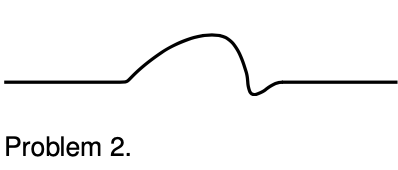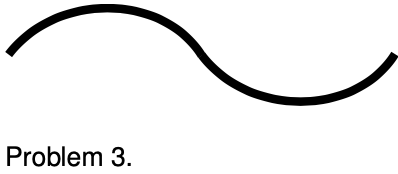LM 19.6 Summary Collection
19.6 Summary by Benjamin Crowell, Light and Matter licensed under the Creative Commons Attribution-ShareAlike license.
Summary
Vocabulary
superposition — the adding together of waves that overlap with each other
medium — a physical substance whose vibrations constitute a wave
wavelength — the distance in space between repetitions of a periodic wave
Doppler effect — the change in a wave's frequency and wavelength due to the motion of the source or the observer or both
Notation
λ — wavelength (Greek letter lambda)
Summary
Wave motion differs in three important ways from the motion of material objects:
(1) Waves obey the principle of superposition. When two waves collide, they simply add together.
(2) The medium is not transported along with the wave. The motion of any given point in the medium is a vibration about its equilibrium location, not a steady forward motion.
(3) The velocity of a wave depends on the medium, not on the amount of energy in the wave. (For some types of waves, notably water waves, the velocity may also depend on the shape of the wave.)
Sound waves consist of increases and decreases (typically very small ones) in the density of the air. Light is a wave, but it is a vibration of electric and magnetic fields, not of any physical medium. Light can travel through a vacuum.
A periodic wave is one that creates a periodic motion in a receiver as it passes it. Such a wave has a well-defined period and frequency, and it will also have a wavelength, which is the distance in space between repetitions of the wave pattern. The velocity, frequency, and wavelength of a periodic wave are related by the equation
v=fλ.
A wave emitted by a moving source will be shifted in wavelength and frequency. The shifted wavelength is given by the equation
where v is the velocity of the waves and vs is the velocity of the source, taken to be positive or negative so as to produce a Doppler-lengthened wavelength if the source is receding and a Doppler-shortened one if it approaches. A similar shift occurs if the observer is moving, and in general the Doppler shift depends approximately only on the relative motion of the source and observer if their velocities are both small compared to the waves' velocity. (This is not just approximately but exactly true for light waves, and as required by Einstein's Theory of Relativity.)
Homework Problems
1. The following is a graph of the height of a water wave as a function of position, at a certain moment in time

Trace this graph onto another piece of paper, and then sketch below it the corresponding graphs that would be obtained if
(a) the amplitude and frequency were doubled while the velocity remained the same;
(b) the frequency and velocity were both doubled while the amplitude remained unchanged;
(c) the wavelength and amplitude were reduced by a factor of three while the velocity was doubled.
Explain all your answers. [Problem by Arnold Arons.]
 2. (a) The graph shows the height of a water wave pulse as a function of position. Draw a graph of height as a function of time for a specific point on the water. Assume the pulse is traveling to the right.
2. (a) The graph shows the height of a water wave pulse as a function of position. Draw a graph of height as a function of time for a specific point on the water. Assume the pulse is traveling to the right.
(b) Repeat part a, but assume the pulse is traveling to the left.
(c) Now assume the original graph was of height as a function of time, and draw a graph of height as a function of position, assuming the pulse is traveling to the right.
(d) Repeat part c, but assume the pulse is traveling to the left.
Explain all your answers. [Problem by Arnold Arons.
 3. The figure shows one wavelength of a steady sinusoidal wave traveling to the right along a string. Define a coordinate system in which the positive x axis points to the right and the positive y axis up, such that the flattened string would have y=0. Copy the figure, and label with y=0 all the appropriate parts of the string. Similarly, label with v=0 all parts of the string whose velocities are zero, and with a=0 all parts whose accelerations are zero. There is more than one point whose velocity is of the greatest magnitude. Pick one of these, and indicate the direction of its velocity vector. Do the same for a point having the maximum magnitude of acceleration. Explain all your answers.
3. The figure shows one wavelength of a steady sinusoidal wave traveling to the right along a string. Define a coordinate system in which the positive x axis points to the right and the positive y axis up, such that the flattened string would have y=0. Copy the figure, and label with y=0 all the appropriate parts of the string. Similarly, label with v=0 all parts of the string whose velocities are zero, and with a=0 all parts whose accelerations are zero. There is more than one point whose velocity is of the greatest magnitude. Pick one of these, and indicate the direction of its velocity vector. Do the same for a point having the maximum magnitude of acceleration. Explain all your answers.
4. (a) Find an equation for the relationship between the Doppler-shifted frequency of a wave and the frequency of the original wave, for the case of a stationary observer and a source moving directly toward or away from the observer.
(b) Check that the units of your answer make sense.
(c) Check that the dependence on vs makes sense.
5. Suggest a quantitative experiment to look for any deviation from the principle of superposition for surface waves in water. Make it simple and practical.
6. The musical note middle C has a frequency of 262 Hz. What are its period and wavelength? √
7. Singing that is off-pitch by more than about 1% sounds bad. How fast would a singer have to be moving relative to the rest of a band to make this much of a change in pitch due to the Doppler effect?
8. In section 19.2, we saw that the speed of waves on a string depends on the ratio of T/μ, i.e., the speed of the wave is greater if the string is under more tension, and less if it has more inertia. This is true in general: the speed of a mechanical wave always depends on the medium's inertia in relation to the restoring force (tension, stiffness, resistance to compression,...). Based on these ideas, explain why the speed of sound in air is significantly greater on a hot day, while the speed of sound in liquids and solids shows almost no variation with temperature.
19.6 Summary by Benjamin Crowell, Light and Matter licensed under the Creative Commons Attribution-ShareAlike license.
Calculators and Collections
Equations
- Wavelength of Doppler-shifted wave vCollections Use Equation
- Velocity of wavelength (frequency) vCollections Use Equation
- Velocity of a Pulse on a String vCollections Use Equation
- Transverse force on a string segment vCollections Use Equation
- Velocity of wavelength (period) vCollections Use Equation
- Acceleration from Force and Mass KurtHeckman Use Equation
- Comments
- Attachments
- Stats
No comments |
